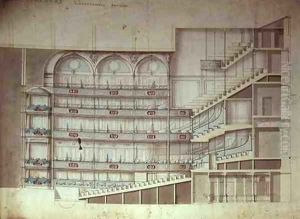Henry Holland Paintings
Henry Holland was a prominent English architect during the 18th century, known for his significant contributions to Georgian architecture. Born in 1745 in Fulham, London, Holland was part of a family with strong connections to the building and design world; his father, Henry Holland Sr., was a successful builder. This environment provided young Holland with early exposure to the principles of design and construction, which laid the foundation for his future career. Holland initially started working under the tutelage of his father and later expanded his knowledge and skills by apprenticing with the renowned architect Capability Brown. This partnership was pivotal, as Brown was not only a leading landscape architect of the time but also involved in numerous architectural projects, giving Holland invaluable experience in both domains.
Holland's career took a significant turn when he married Bridget Brown, Capability Brown's daughter, further cementing his connections within the architectural and landscaping worlds. This alliance opened up new opportunities for Holland, and he began to establish himself as a capable and innovative architect. One of his early works, Brooks's Club in St James's Street, London, showcased his ability to blend functionality with aesthetic appeal, a hallmark of his designs. Holland's architecture is characterized by its elegant simplicity, harmonious proportions, and the seamless integration of buildings with their surrounding landscapes.
Throughout his career, Holland was responsible for designing and overseeing the construction of numerous country houses, urban dwellings, and public buildings. Notable among these is Carlton House, which was commissioned by the Prince Regent (later King George IV) and is considered one of Holland's masterpieces. Although much of Carlton House was later demolished, it was influential in setting trends for Regency architecture. Holland also played a key role in the development of the Brighton Pavilion, another iconic building that reflects the eclectic tastes of the Regency period.
In addition to residential and public buildings, Holland contributed to the development of planned residential areas, most notably in parts of London. His designs for Hans Town, now known as Chelsea, included a series of terraces that were highly sought after and praised for their innovative layout and design. Holland's work significantly influenced the architectural landscape of London and beyond, making him a key figure in the transition from Georgian to Regency architecture.
Henry Holland's contributions to architecture were not limited to individual projects. Through his collaborations, innovative designs, and the mentoring of future architects, he played a crucial role in shaping the architectural practices of his time. Holland's legacy is evident in the continued admiration for his work and the principles of balance, proportion, and integration that he championed. He passed away in 1806, leaving behind a body of work that continues to be studied and appreciated for its elegance and innovation.


